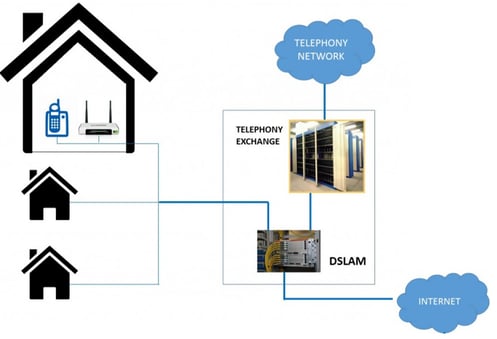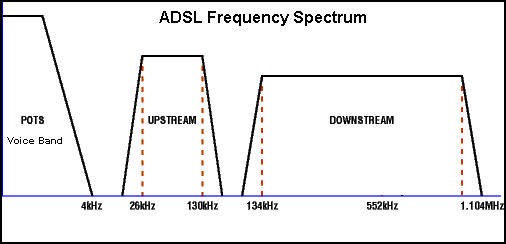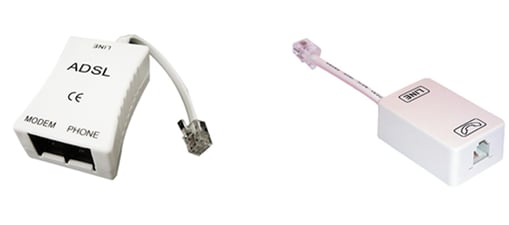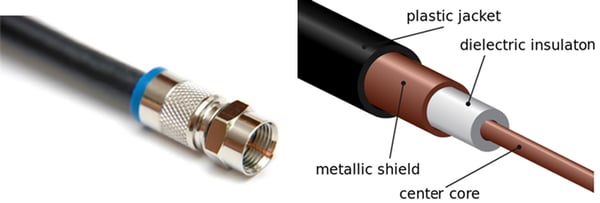
An enterprise network is not truly functional unless it is connected to the internet. The types of technologies that can be used for network edge connectivity can broadly be separated into two groups: commercial-grade and high-grade WAN connection technologies.
The distinction between the two has to do with available speeds, reliability, services, and cost. High-grade WAN connectivity technologies include Metro Ethernet and MPLS, while commercial-grade options include cable and xDSL.
In this article, we examine the commercial-grade WAN technologies (cable and xDSL), how they function, and their most typical implementation scenarios.
Connectivity via an existing infrastructure
Several decades ago, in the era of dial-up internet, 56-baud PSTN modems were all the rage. But as the demand for higher speeds increased, a faster way to connect to the internet was needed. In an ideal world, every home and business would be connected to the internet at multigigabit speeds via a fully connected fiber optic network. Because such universal connectivity is not yet feasible, a way had to be devised to bring broadband services to the subscriber’s premises at a reasonable cost.
The solution was to use existing infrastructure in a new way. The existing infrastructure with the highest degree of penetration into homes and businesses was the telephone network and the cable TV network.
xDSL fundamentals
xDSL technology uses telephone lines, the infrastructure that arguably has the highest penetration into homes and businesses worldwide. Although it is called Digital Subscriber Line, xDSL is an inherently analog technology. It takes data in digital format, modulates it in analog form and sends it over the wire. A DSL line is terminated on what we often call a modem. This device, however, is not just a modem – in most cases today, it has a switch, a router and a wireless access point integrated into it.
At the other end of the link, at the central office of the telco, is what is called a DSL Access Multiplexer, or DSLAM. This device connects multiple DSL lines and multiplexes them together. xDSL is carried over telephone lines that also carry voice conversations, so the DSLAM is responsible for separating the voice from the data and sending the voice to the telephony exchange and the data to the internet. This is depicted more clearly in the following diagram.

Note here that the xDSL technology exists only between the xDSL device on the customer’s premises, and the DSLAM. As such, xDSL is exclusively a “last mile” or “local loop” technology.
xDSL and voice
So, if xDSL uses the same pair of copper wires coming into your home or business that deliver telephone services, then what happens to the voice using that wire? Both voice and data can run over the same copper pair simply because each uses a different frequency. Specifically, voice uses frequencies between 300 and 4000 Hz, while some types of xDSL may use frequencies of well over 1 MHz. This means that, if implemented correctly, both voice and data can coexist on the same wire without interference. The following diagram depicts the frequency spectrum used by Asynchronous DSL or ADSL.

Note that a different frequency range is used for the Plain Old Telephone Network (POTS), a different range for data upload, and a different range for data download.
Customer premises wiring
DSL uses the same copper wires as those used by the PSTN voice line. Even though it uses much higher frequencies on the same line, these frequencies can and do overflow into the voice channel. This can result in static on the line or even lost data connectivity during a phone call. For this reason, either filters or a splitter must be used to allow both voice and data to function optimally.
The following are examples of a splitter (L) and filter (R).
 A splitter is used at the location where the phone line enters the premises. The connection can split the voice and data at this location, have the modem connect to the data portion, and the phone portion can be connected to the internal wiring of the premises for telephony. When a splitter is used, filters are unnecessary. Alternatively, filters can be used at each telephone. In such a case, a splitter is unnecessary.
A splitter is used at the location where the phone line enters the premises. The connection can split the voice and data at this location, have the modem connect to the data portion, and the phone portion can be connected to the internal wiring of the premises for telephony. When a splitter is used, filters are unnecessary. Alternatively, filters can be used at each telephone. In such a case, a splitter is unnecessary.
Many new implementations of xDSL provide VoIP services to the modem itself. Voice is delivered via VoIP packets over the data connection rather than via traditional methods over the wire. This means an analog telephone can be connected into an FXS port on the modem, eliminating the need for splitters, filters, and complex wiring.
xDSL types
xDSL is denoted by the acronym with a lowercase “x” at the beginning. This is because xDSL comes in various flavors, each of which is denoted by a particular letter that replaces the “x”.
Looking carefully at the frequency spectrum shown earlier, you will notice that the upstream frequency range is much smaller than the downstream range. This is because the type of xDSL being used is asynchronous, meaning that upload and download speeds are not the same. This type of DSL is often used for residential or small businesses. These users typically require more bandwidth for downloading than uploading, so ADSL is optimized for such use. Although Symmetrical DSL (SDSL) also exists, Asymmetric DSL has achieved such high speeds that SDSL is no longer being developed.
Some of the most recent high-performance xDSL technologies include:
- Asynchronous DSL (ADSL, ADSL2, ADSL2+), with speeds achieving up to 24 Mbps down and 3.3 Mbps up
- Very-high-bit-rate DSL (VDSL), with speeds typically at 50 Mbps down and 16 Mbps up
- Very-high-bit-rate DSL 2nd generation (VDSL2), with speeds up to 100 Mbps in both directions
- Fast (ITU-T G.9700 and G.9701 standards), with speeds up to 1 Gbps in both directions
xDSL limitations
There is no such thing as a silver bullet. Like most technologies that have been developed to run over an inherently non-optimal infrastructure, there are limitations. The most profound limitation is the wire distance between the subscriber’s premises and the DSLAM. As the length of the wire increases, speeds decrease. This is why xDSL speeds of a particular link are always described as speeds “up to” a certain value.
This limitation is quickly being overcome by moving the DSLAM closer to subscribers. Instead of having a single DSLAM in the central office, telcos are placing connection nodes containing DSLAMs in more remote neighborhoods. These are then connected to the central office via fiber optic cabling, thereby increasing achievable speeds by shortening the distance between the DSLAM and the subscriber.
Connectivity over the cable TV network
Another high-penetration infrastructure used to supply internet connectivity is the cable TV network. Unlike DSL, the cable TV network is a shared medium where multiple users in an area share a common downstream capability. Cable internet is governed by the Data Over Cable Service Interface Specification (DOCSIS).
Cable network architecture
Cable internet utilizes the same coaxial cable that is used for cable TV coming into the customer’s premises. This cable primarily uses F-type connectors as shown in the image below. Coaxial cable is advantageous compared with other copper media because one of the two conductors provides its own shielding, and the dimensions of the cable are controlled by the dielectric insulator to give a precise distance between the two conductors for the full length of the cable, as shown below.

The result is a well shielded and durable cable that can carry data at high speeds.
Most cable TV infrastructures today are designed as a hybrid network that employs fiber optic cabling in the backbone or core of the network, and coaxial cable to connect individual subscribers. Subscribers are connected to the local fiber node via coaxial cable, while the fiber node is connected to the head end, which is a communications node where multiple fiber nodes connect.
Cable internet speeds
Like xDSL, cable internet is primarily an asynchronous WAN technology and is optimized for downloading. Several DOCSIS standards have been developed over the years, the most prominent of which are listed below:
- DOCSIS 3.0, with speeds of 1.2 Gbps down and 200 Mbps up
- DOCSIS 3.1, with speeds of 10 Gbps down and 2 Gbps up
- DOCSIS 3.1 Full Duplex, with speeds of 10 Gbps in both directions
While the maximum speeds are well above those available with xDSL, keep in mind that these speeds are shared among tens or even hundreds of users and can thus vary widely.
Technological considerations
Both cable and xDSL are among the most inexpensive WAN connection technologies available. There are a few important characteristics to keep in mind when considering these technologies:
- Reliability – Typically an ISP providing xDSL or cable internet will not guarantee the often-cited five nines reliability (99.999% uptime) on such connections. Outages due to network maintenance can be expected occasionally. Additionally, if copper cabling entering the premises is not suitably protected from the elements, humidity and corrosion may cause a deterioration in performance. Also, the xDSL and cable modems used as terminating equipment are often low-end consumer electronics and generally don’t have a lifetime beyond several years. This can be a problem for deployments that also carry voice traffic or enable connectivity of network services to customers over the internet. Service level agreements (SLAs) are rarely provided by ISPs for such links.
- Power considerations – Unlike telephony, a power cut will cause a disruption in WAN connectivity because the terminating equipment uses local mains power. ISPs will not certify connectivity in such cases. Each subscriber is responsible for providing uninterruptible power to this and all internal network equipment (such as from a UPS and generator) to ensure connectivity is not affected by power problems.
- Guaranteed bandwidth – These technologies are usually not accompanied by a Certified Information Rate (CIR) that ensures a continuous minimum available bandwidth at all times.
- Static IPs – Neither xDSL nor cable provides a static public IP by default for users wishing to connect to some internal service such as a web server residing on the enterprise’s network. Even so, static IPs can be obtained for an additional cost.
Deployment scenarios
xDSL and cable internet are technologies deployed primarily where a cost-effective solution is necessary, and where extreme levels of availability are not required. Small- to medium-sized businesses or branch offices with anywhere from 2 to 30 or more users are classic examples. Situations where these technologies are unsuitable include:
- Enterprise networks with over 50 employees who make heavy use of the internet for their productivity
- Organizations that need to support a large number of VoIP voice or video conversations
- Companies that provide network services to users on the internet over their WAN connection
- Enterprises that require a guaranteed minimum available bandwidth at all times for their applications to run correctly
- When an SLA is required
Even so, there is a way to make commercial-grade WAN connections approach the benefits that high-grade WAN technologies provide. This can be achieved using what is known as Software Defined WAN (SD-WAN). SD-WANs can seamlessly merge multiple WAN connections and technologies. This means you can achieve the same high availability that you would enjoy from expensive high-grade connections with the use of two or three commercial-grade xDSL or cable connections by employing redundancy and load balancing. The cost savings here would be phenomenal, since some high-grade technologies can be as much as twenty times the cost of xDSL or cable. Click here to learn more about SD-WAN.
Conclusion
Commercial-grade WAN technologies have come a long way since their inception. Today they can supply surprisingly fast speeds at refreshingly low costs. For many SMBs or branch offices, these technologies easily meet their requirements. With SD-WAN adding robustness and reliability, you have even more options for your network.
You may also like:
Know your protocols: VoIP protocols that work together with SIP
Quality of service must-haves for converged networks
Customizing a VoIP deployment for your multisite customer









Comments